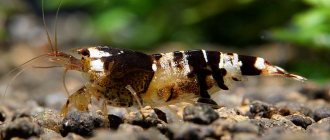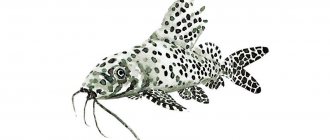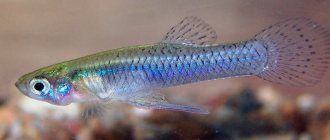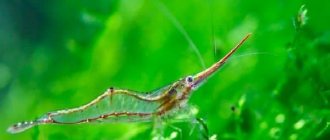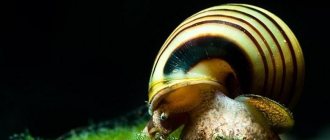Neretina snails have become increasingly popular among aquarists. This species belongs to freshwater snails, although some representatives of this species live in sea water. Neretina owes its popularity to the fact that it perfectly removes all excess dirt in the aquarium. It also has no equal in eating algae. Nowadays, you can most often find the following varieties of this snail:
- Olive Nerite Snail
- Zebra Nerite Snail
- Tiger Nerite Snail
- Horned Nerite Snail
And every day more and more varieties appear that are popular, and the differences between them are only in appearance: O-ring neretina, beeline neretina, solar neretina, and also red-spotted neretina.
Keeping in an aquarium
There is nothing easier than keeping Neretina snails at home and caring for them. Anyone can handle this. They do not require special care, the only thing you need to remember is that these are tropical snails, and that is why they need hard water, they do not like soft water due to the impossibility of forming a shell in it. In water of normal hardness they do not have problems with this. In addition, the water temperature must be at least 24 degrees.
The owners of these snails should definitely watch how much nitrates and ammonia are contained in the water, since they do not tolerate them very well. It must be remembered that every week you need to change up to one third of the water in the aquarium with fresh water. It is also important not to forget that if aquarium fish are sick, there is no need to treat them with drugs containing copper, to which neretins are sensitive.
When you lower the snail into the aquarium, you need to take into account that under no circumstances should you just throw it into the water, but use gentle movements to lower the snail to the bottom. Otherwise, it may die, since it is not very adapted to turning over on its own.
It is also important that the aquarium into which you put the neretina has a lot of plants. This is necessary so that at the very beginning of aquarium life, nerets can eat parts of plants that are rotting. In addition, it will also feed on algae.
Neretin is usually kept only with peaceful ak fish, as well as with invertebrates. Neretina itself causes absolutely no problems. But it can easily suffer, and primarily from large fish or fish that feed on snails.
Diseases
Snail diseases most often occur due to improper care and poor nutrition. If you control all water parameters - hardness, acidity and temperature, then some diseases can be avoided. For example, deformation and layering of the shell.
If a crack has formed on the snail’s shell or a piece of the shell has broken off, then provide the neretina with rest and introduce a large amount of calcium into her diet and after a while the shell will grow together.
If a white coating appears on the shell, then this is a sign of aging of the mollusk.
A mold-like coating may indicate a fungal infection. Such an individual must be isolated from its relatives and given baths with salt or potassium permanganate. Other snails must also be monitored to avoid infection.
After purchase, it is recommended to place all new snails in a separate container and observe them for several days. And only after you make sure that the new pets are healthy, they can be allowed into the general aquarium. This is done for prevention, because it is unknown how and where the new inhabitants of your aquarium were kept.
What does neritina look like?
Its shell is large, massive, and shaped like a drop.
The operculum (a kind of lid or “hatch” that completely or partially covers the hole in the shell) is small, off-center and grows only on one side, and not on all sides.
The head and leg are oval, the mouth is round. The antennae are thread-like. The eyes are located on small irregularities.
The body is most often gray, and the head and mantle are black or brownish-gray with speckles. The body is almost completely covered by the shell.
The average size of neritina depends on its type and is approximately 2 cm. Slightly larger are the zebra and tiger varieties, which grow up to 2.5 cm.
The shells of these mollusks can be colored very differently, and there are simply no two snails with the same pattern. Black, dark brown, dark green, olive and even red-orange individuals are known. Their covers are decorated with a pattern of stripes, spots, dots, and strokes, and the shell itself may have outgrowths or horns.
Neritines are not hermaphrodites, but it is not possible to distinguish their gender, since there are simply no external signs.
These snails do not live long: one, maximum two years. Very often they die immediately after being placed in a new aquarium or after a week. This is due to hypothermia during transportation, or a sudden change in living conditions.
A dead snail decomposes quickly, spoils the water very much and smells unpleasant in the aquarium. For this reason, we advise you to regularly check your home pond and remove dead ones in a timely manner.
Snail color and lifespan.
Neretinas live on average about a year. Common reasons for the death of this mollusk are a sudden change in living conditions and hypothermia during delivery from the store to home. The length of neretina can reach 2.5 cm, and the color can be very diverse: from black to green with stripes, dots and spots of various shapes.
Feeding shellfish.
Neretins are the best destroyers of all kinds of algae. These active snails are constantly on the move, leaving a clean trail behind them. Mollusks do not harm aquarium plants, but they cannot get rid of all algae. Since algae appears as a result of an imbalance in the aquarium, this problem must be solved first.
In addition to their favorite foods, neretinas should be given cereal flakes and an algae called spirulina. While consuming food, the snail constantly crawls from place to place, and then can freeze for a long time. Do not panic ahead of time, thinking that your pet has died. You need to smell the neretina, because a dead snail has an unpleasant odor.
Feeding
Neretina is a useful inhabitant of the aquarium, eating rotting aquatic plants and harmful algae. Their small size allows them to get everywhere, cleaning not only the walls of the tank, but also the substrate and decoration elements. Moreover, snails do not spoil healthy plants.
Usually this food is enough for neretinas. But if at first there is not enough of it in the new aquarium, then they will not refuse any fish food.
Algae destroys any type of algae - red, green, filamentous, black beard, Vietnamese. They are almost always on the move and very active, so you can always see a clean strip in the aquarium where the neretina has “passed”, eating the growths.
Varieties of neritin
The most common species kept in aquariums are:
"Beeline" (Clithon corona). They were brought from China and the Philippine Islands. These are small snails measuring only 1-1.2 cm.
"Tiger" (Neritina turrita). Came to us from Southeast Asia. Quite large, growing up to 2-2.5 cm. The shell is round. It is surrounded by dark orange or light brown stripes. Dark (black or brown) lines are clearly visible at the top. The pattern of each individual is individual, and all the stripes are of different thicknesses.
"Zebra" (Neritina natalensis zebra). Distributed in Kenya, South Africa and throughout the territory between them. They inhabit mangrove swamps and lagoons. These are giants among neretina, growing up to 2.5-3.5 cm. Their body is painted in greenish-yellow or yellowish-brown tones. Against this background there are wide black stripes in the form of zigzags or oblique lines. In the front part of the shell, the dark stripes thin out, and there are more yellow areas. The body tone is grayish or reddish-yellow. It was noted that escapees from aquariums are most common among “zebras.”
Red-spotted, ring-striped (Neritina natalensis). They were brought from Indonesia and Sulawesi. Similar in size to the previous view. They love warm water (28-30°C), cannot tolerate the presence of copper in water and react negatively to acidity below 7 (their shell disintegrates and they die). Their shells are mahogany-colored and covered with trails of black spots.
Olive (Olive Nerite Snail). It’s strange, but there is practically no information about it, only general questions of content. (Horned Nerite Snail). Found in countries such as Japan, Thailand, China, Indonesia and the Philippines. They prefer lagoons and the mouths of small rivers, the bottom of which is rocky or sandy. It was nicknamed Horned because of the growths on its shell. These spines are very similar to horns. In each individual, these horns are located differently. Sometimes they are broken off, but this does not in any way affect the health and well-being of the snail.
The growths are protection from enemies, since their sting is quite noticeable. The shell is covered with alternating yellow-olive and black stripes. These mollusks do not grow large, only up to 1-2 cm. They live from 2 to 5 years. They don't get out of the water. If this does happen, it means that they are not satisfied with the conditions that need to be adjusted.
Kinds
There are many types of neritine snails, differing in shape, shell color, and living conditions.
Some popular representatives of the genus:
- Neritina turrita – tiger snail, zebra snail. The shell is light brown or orange in color with black stripes of varying thickness and really stands out in the aquarium.
- Neritina natalensis - Zebra Neritina. One of the most common snails with a small yellow or yellow-orange shell with black stripes from the top to the very base of the shell.
- Neritina natalensis sp . — Neritina red dotted. This representative has an orange-hued shell with rows of small and large dots of various shapes.
- Neritina coromandelia - Striped zebra snail.
- Neritina juttingae - Neritina hedgehog. It has a light brown shell with spines reminiscent of hedgehog spines, which is why it got its name.
- Neritina pulligera - Neritina Black Ear. The shell of this snail is dark, almost black, and its shape is more flattened than that of other members of the genus and is similar to a human ear.
Character and compatibility of neritin
Neighborhood with
- macrobrachium (shrimp),
- crayfish,
- crabs,
- predatory snails Helena,
- cichlids,
- macrognathus,
- boots,
- macropods,
- tetraodons,
- large catfish such as Clarius,
- cockerels, etc.
It is not advisable to keep it with other snails. Ampularia, Brotia, Pagoda, Coil, Physa, Pokemon and others that eat algae will compete with Neretina for food. As a result, the latter may die of hunger. The only exceptions are bivalve mollusks, melania.
With whom can they be kept? With all the friendly fish and invertebrates. These snails themselves are very peaceful and do not bother the other inhabitants of the aquarium.
Habitat
The natural habitats of this mollusk are:
- Philippines,
- Indonesia,
- China,
- Taiwan,
- Japan,
- Thailand and Malaysia.
All these places have one thing in common - the presence of desalinated areas of the seas, with fresh or brackish water. After all, the presence of brackish water is necessary for the reproduction process of these snails. The lifespan of a horned snail is about 5 years.
Snail breeding
Neretines are not hermaphrodites; snails need individuals of both sexes to reproduce, but it is very difficult to determine their gender. These gastropods are not bred in fresh water; even the use of sea water can rarely lead to a positive result.
To produce offspring, snails should be provided with conditions similar to their natural habitat. But, despite this, the Neretina snail still continues to lay eggs on the ground, plants and various hard surfaces. Since there are many eggs in the clutch and they are hard white dots, this spoils the aesthetic appearance of the aquarium.
In order for snails to stop their fruitless attempts to breed offspring, you just need to add several relatives to them. This has a calming effect on the mollusks, that they no longer need to worry about procreation, and can calmly enjoy life.
As a result, when purchasing neretin for an aquarium, you need to be prepared for decoration in the form of white polka dots. But omitting this drawback, this snail is perfect for the role of a beloved pet.
Behavior
Be prepared that Bumblebee Nerite may attempt to escape. Therefore, the presence of a lid or glass on the aquarium is mandatory. The reasons for escape may be hunger or a violation of the biological balance. If mollusks repeatedly try to escape from the aquarium, then it is worth reviewing the conditions of their detention.
Snails of this species can live for some time without water. And if they do run away, then look for them nearby. If you find any escapees, carefully pick them up and return them to the aquarium.
How to introduce neritin into an aquarium
It will be better if the aquatic environment in the aquarium is already established and balanced.
In such a reservoir, the water parameters are stable, so the snails adapt faster. There are a lot of plants here, and therefore rotting remains, which will provide the neretinas with food at the initial stage.
It also contains a lot of the main food of these mollusks - algae.
It is important to introduce snails into the aquarium correctly. Do not throw it haphazardly, but turn it over into the correct position and carefully lower it into the water.
If at least one individual falls upside down, it will not be able to turn over on its own and will die.
Housing size for neretines
They are unpretentious in this matter too and feel good in a tank of any size. But overpopulation should not be allowed - only a few young individuals can be housed in a 40-50-liter container. Otherwise, the mollusks will be crowded, there will not be enough food, and the water parameters will change greatly.
In the case of neretinas, the same rule applies as when keeping other aquarium inhabitants - the more spacious the tank, the better. Although several snails can be placed in a small aquarium.
What to look for when buying neritin
- You need to carefully inspect the sink for cracks and other damage.
- If possible, observe the behavior of snails. It is better not to take specimens lying on the bottom.
- Be sure to look inside the sink. No matter how funny it may sound, there are known cases of buying empty sinks.
Let's summarize. The Neretina snail for an aquarium is wonderful for everyone: it is beautiful, it is an unsurpassed cleaner, it does not harm plants and other inhabitants of the aquarium, it is not difficult to acquire, it is easy to care for, and it will not burden you with unwanted offspring. The only drawback is that the egg laying spoils the appearance, but this is quite easy to fix.
PHYSAL SNAIL CONTENTS COMPATIBILITY REPRODUCTION DESCRIPTION PHOTO VIDEO.
AQUARIUM SNAIL COIL CONTENTS REPRODUCTION COMPATIBILITY DESCRIPTION PHOTO.
AMPULAR CONTENTS REPRODUCTION COMPATIBILITY PHOTO DESCRIPTION.
Nutrition
The question of what to feed ampullaria is quite relevant for beginning breeders, but there is nothing complicated about it. Ampullaria snails eat almost any food offered to them. Also an undoubted advantage is the fact that the mollusks will pick up all the food that has not been eaten by other inhabitants of the aquarium and eat it, thereby preventing the water from spoiling.
The easiest way to feed aquarium ampularia is with pressed catfish tablets or fresh vegetables. The best vegetables are:
- zucchini,
- cucumber,
- lettuce leaves,
- shoots of nettle or dandelion.
Vegetables should be boiled for two to three minutes, and lettuce leaves should simply be doused with boiling water for disinfection purposes. If the snails have not eaten the food offered to them within 24 hours, it is better to remove it from the aquarium so that the water does not become cloudy and spoil.
As food of animal origin, you can offer snails bloodworms, tubifex worms, earthworms cleared of soil, daphnia or similar live food.
To avoid damage to the aquarium vegetation, do not leave the snails hungry; they will easily eat all the vegetation in the aquarium if they do not find another food source containing spirulina.
Nutrition
Melania snails are omnivores; they will enjoy the remains of fish food, algae, and in some cases, even dead inhabitants of the aquarium.
To reduce the destruction of algae, you should feed melania with tablets for catfish. Vegetables can also be eaten:
- cucumber,
- zucchini,
- lettuce or spinach,
- banana peel.
But pay attention to uneaten food remains; if the food is not eaten within 24 hours, it is better to remove its remains from the aquarium in order to prevent water contamination
Melania, a snail whose appearance signals problems with oxygen in the aquarium; if the mollusk experiences oxygen starvation, it rises along the wall of the aquarium closer to the surface of the water. This signal should not be ignored. You need to find out the reason for the lack of oxygen in the lower layers of the aquarium water, and take care of eliminating it.
What to feed
Tigers are not particularly picky, the main thing is that the vegetables and fruits are fresh and of good quality. They happily eat:
- cucumbers,
- you can feed with zucchini,
- pumpkin,
- sweet potato,
- tomatoes,
- lettuce leaves.
From fruits you can offer your pet:
- pears,
- apples and sweet varieties,
- bananas.
It is interesting that each individual has its own preferences, so first you need to observe what your pet likes most. There are specimens that even eat boiled buckwheat with meat puree for baby food, and they also choose the type of meat they like. You can also feed it by grinding cereals.
In order for the mollusk to have enough calcium for constant shell growth, it needs additional feeding. Calcium is contained in shell rock, natural chalk, natural sepia (snails love to crunch on it), and special feed chalk is also sold. To make the tiger snail more actively consume calcium, chopped vegetables and fruits can be sprinkled with grated chalk and raw egg shells crushed into powder. But it is better to give less protein supplements.
Leg
The covering of Chrysomallon's leg consists of hundreds of scales (sclerites). These plates can reach a length of 8 mm and have different colors.
The basis of sclerite is conchiolin, and a layer of iron sulfides covers it on top. At the same time, at first biologists believed that the composition of the iron snail’s scales was the same as that of the operculum with which an ordinary mollusk closes the mouth. But the analyzes showed that this is not so. The operculum itself (operculum) is hidden in the chestnut-shaped gastropod under the sclerites.
The protective scales of the iron snail are inhabited by a large number of different microorganisms. There is a possibility that with the help of these bacteria its mineralization occurs.
